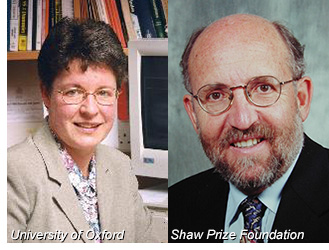Council Names Two New Honorary Members to the AAS

Richard Fienberg Running Hare Observatory
Bell Burnell earned her bachelor's degree in physics at the University of Glasgow and her doctorate in radio astronomy at the University of Cambridge. She was still a graduate student when she found a celestial source of unprecedentedly fast, periodic radio pulses — a rapidly rotating, highly magnetized neutron star, or pulsar. Bell Burnell's career has taken her to the University of Southampton, University College London, Open University, the Royal Observatory Edinburgh, the University of Bath (where she served as dean of science), Trinity College Dublin, and the University of Oxford. She has been president of the Royal Astronomical Society and the Institute of Physics and is a Fellow of the Royal Society.
This is not the first time the AAS has honored Bell Burnell. In 1986 she was the inaugural recipient of the Society's Beatrice M. Tinsley Prize, which recognizes an outstanding research contribution of an exceptionally creative or innovative character. When AAS President Meg Urry informed her of her honorary membership, Bell Burnell responded, "I opened your email this morning before some intensive meetings — what a great way to start the day! Thank you and the AAS so much — I am greatly honoured."
Mayor studied at the University of Lausanne before earning his doctorate at the University of Geneva, where he has spent nearly his entire career. He served as director of Geneva Observatory from 1998 to 2004 and is the principal investigator of the High Accuracy Radial-velocity Planetary Search (HARPS) spectrograph on the European Southern Observatory's 3.6-meter telescope atop La Silla, Chile. It was with a forerunner of that spectrograph that Mayor and graduate student Queloz found periodic radial-velocity variations in the main-sequence G-type star 51 Pegasi, indicating the presence of a Jupiter-mass planet in a tight, 4.2-day orbit. Twenty years later, the discovery and characterization of exoplanets around normal stars is one of the most active fields in the astronomical sciences, and Mayor has been recognized with numerous awards, including the Shaw Prize (which he shared with AAS member Geoffrey Marcy), the Ambartsumian Prize, and associate membership in the US National Academy of Sciences.
In response to President Urry's email notifying him of his latest honor, Mayor wrote, "I am extremely proud for having been named as an honorary member of the AAS. This recognition by colleague astronomers is, for me, of very special importance."
Nominations for honorary membership may be submitted at any time throughout the year to the AAS Secretary and should be signed by no fewer than five members of the Society.


